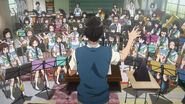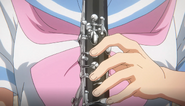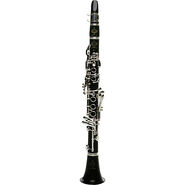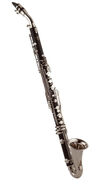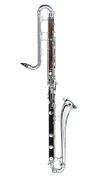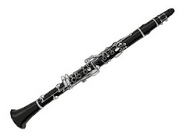The Clarinet (クラリネット Kurarinetto) is a family of woodwind instruments. A person who plays any type of clarinet is called a clarinetist or clarinet player.
Construction[]
A clarinet is usually made out of plastic or wood. Many student instruments are made out of plastic, while most professional instruments are made out of wood. It consists of a straight cylindrical tube with an approximately cylindrical bore and a flaring bell. The clarinet is divided into 5 sections: the mouthpiece, which contains the single reed, the barrel, which is used to flatten or sharpen the pitch of the instrument, the upper and lower joints, which contain the instrument's 22 keys, and the bell.
Variants[]
The term clarinet now normally refers to the B♭ soprano clarinet, the most commonly used type of clarinet in concert bands and orchestras, though there are many members of the clarinet family, including some rare instruments like the A♭ piccolo clarinet, the D Clarinet, the C clarinet, the G clarinet (clarinet d’amore), and the basset clarinet. Here are some of the most common clarinets encountered today:
E-flat Clarinet[]
The E-flat Clarinet, piccolo clarinet or sopranino clarinet is the highest pitched and smallest member of the clarinet family used in most ensembles. It is pitched in E♭ like the alto and baritone saxophones, thus being a perfect fourth higher than the B♭ soprano clarinet.
A Clarinet[]
The A clarinet is a member of the clarinet family pitched in the key of A, commonly used in orchestras. Most professional clarinetists will have at least one B♭ clarinet and one A clarinet, as they are used almost equally as often as the former in orchestral music. However, they are almost never used in concert band or other band music, in favor of the B♭ variety.
Basset Horn[]
Despite looking a lot like the alto clarinet, this instrument is pitched in F (or less often in G), a fourth below the B♭ clarinet. The basset horn is fairly rare; it only appears occasionally in orchestral music. and almost never makes an appearance in bands. It was said to be Mozart's favorite woodwind instrument. He scored for it in pieces like the Grand Partita and the Requiem.
Alto Clarinet[]
The alto clarinet or less frequently the tenor clarinet is a member of the clarinet family pitched in E♭, an octave below the E♭ soprano clarinet. It covers the range between the soprano and bass clarinet. This instrument is most commonly seen in concert bands, however not every ensemble has an alto clarinetist, such as the Kitauji High School Concert Band.
Bass Clarinet[]
The bass clarinet is the most common member of the clarinet family outside of the B♭ soprano clarinet. It is invariably pitched in the key of B♭, and is pitched an octave below the B♭ soprano clarinet.
Contra Clarinets[]
The contra-alto clarinet and contrabass clarinet, collectively known as the contra clarinets are the two lowest members of the clarinet family. The contra-alto is pitched in E♭, one octave below the alto clarinet, and the contrabass is pitched in B♭, one octave below the bass clarinet. These clarinets are not especially common in any type of music, but they are most prevalent in concert bands. Some higher-level pieces call for the instruments, and they are seldom used in high school concert bands.
Performance[]
Clarinets produce sound with a reed—a thin and fragile sliver of cane, or, in modern times, plastic. The reed vibrates against the mouthpiece as the player blows into it, producing the distinct tone of the instrument. Different strengths or hardness of reed can be used to provide different tones, however, the harder the reed, the more air it needs to play.
Clarinetists are very careful about their reeds- they are so careful about their reeds that they are often teased for being obsessed with their reeds. For a clarinetist, the greatest tragedy is the destruction of their favorite reed. There is also a running gag among clarinetists and musicians that everything that goes wrong with a clarinetist's performance is attributed to the reed. "When in doubt, blame the reed." is a common saying.
In a concert band setting, the principal clarinetist is typically responsible for providing a tuning pitch for the band (normally the role of the oboe in a symphony orchestra). The three most common tuning pitches clarinetists may provide are a concert B♭ (as given by Hirone Torizuka), an A, and/or and F.
In many concert bands, the principal clarinetist is the equivalent of the concertmaster or concertmistress in a symphony orchestra. They are the second most significant person in the band after the conductor, and are typically ranked highest out of all the section principals in terms of the group pecking order. Some bands recognize the principal clarinetist with a separate stage entrance, during which they bow to the audience and tune the band before the conductor's entrance.
Scoring[]
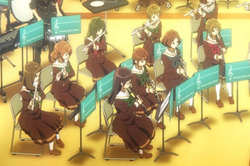
Maina Kase performing on the E♭ clarinet, which is slightly smaller than the other B♭ clarinets
A typical B♭ clarinet section in a concert band can range from as few as 6 clarinets to as many as 30, and bass clarinets usually number between 1 and 4. The B♭ clarinets are divided into three parts—firsts, seconds, and thirds—in a pyramid ranking with more thirds than seconds, and more seconds than firsts.
Since the middle of the 19th century, the bass clarinet has become an essential addition to the orchestra and wind band.
E♭ clarinets of both the sopranino and alto variety tend to only have one or at max two of each in a section, and oftentimes neither or one is missing, particularly the E♭ sopranino clarinet since not every piece has a part for it. It is not uncommon for an E♭ clarinetist to switch to or from a B♭ clarinet if one of the pieces does not call for E♭ clarinet.
Today, the clarinet is commonly used in classical music (such as concert bands, orchestras, chamber music, and solo repertoire), military bands, marching bands, klezmer, and jazz.
As portrayed in Sound! Euphonium[]

Clarinetists of Kitauji High School
There are 11 students who play clarinet and 2 students who play bass clarinet in Kitauji High School Concert Band, including:
- Maina Kase - Designated E♭ clarinet
- Hirone Torizuka - 1st clarinet, clarinet section leader, principal B♭ clarinet, concertmistress
- Rie Shima - 1st clarinet/Clarinet section leader (Our Promise)
- Hiyoko Ueda - 1st clarinet
- Sakiko Suzuka - 2nd clarinet
- Shouko Hagiwara - 2nd clarinet
- Youko Matsuzaki - 2nd clarinet/Bass clarinet (Our Promise)
- Sugami Tanaka - 3rd clarinet
- Yumina Ooguchi - 3rd clarinet
- Chieri Takahisa - 3rd clarinet/Designated E♭ clarinet (Our Promise)
- Hisae Takano
- Hitoshi Usui - Bass clarinet
- Junko Koshigawa - Bass clarinet
In Sound! Euphonium: The Movie - Our Promise: A Brand New Day, several new clarinet players and a bass clarinet player join the ensemble:
- Maya Hashida
- Miki Katou
- Seiko Ashida
- Shiori Hiranuma
- Tairu Kitayama
- Taku Imura
- Ayako Sakasaki - Bass Clarinet
Trivia[]
- Clarinetists are usually stereotyped as being very cliquey or very weird in the band, usually with the exception of the section leader. To some degree, Hibike! Euphonium stays true to this stereotype; the clarinet section in the transition card has many bizarre things, like a model planet and a hand puppet.
Gallery[]
| Musical instruments in Sound! Euphonium | |
|---|---|
| Woodwinds | |
| Brass | |
| Strings | |
| Percussion | |
| Other | |





